weight AUDI Q5 2015 Owners Manual
[x] Cancel search | Manufacturer: AUDI, Model Year: 2015, Model line: Q5, Model: AUDI Q5 2015Pages: 302, PDF Size: 75.01 MB
Page 6 of 302
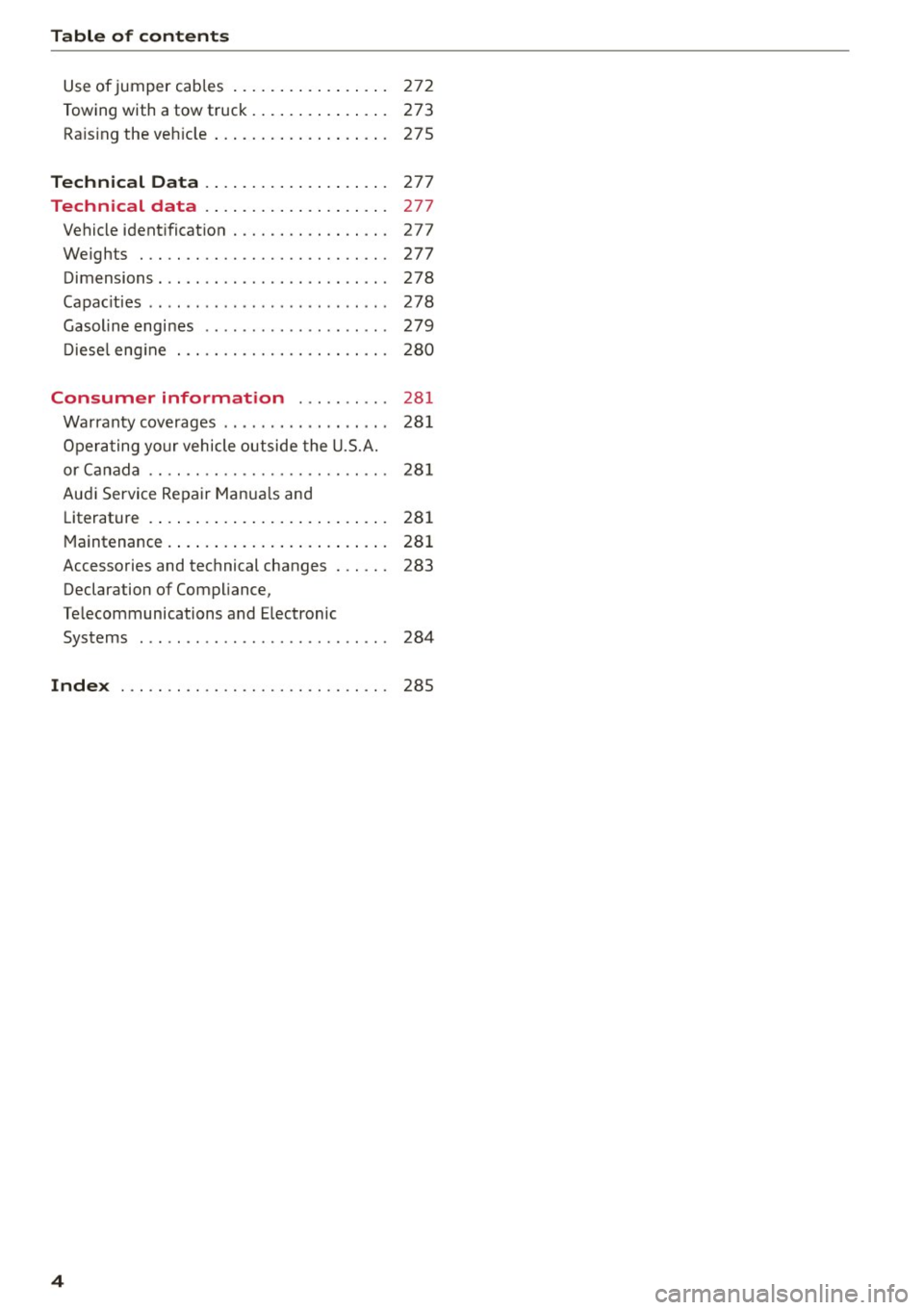
Table of contents
Use of jumper cables . . . . . . . . . . . . . . . . . 272
Towing with a tow truck. . . . . . . . . . . . . . . 273
Raising the vehicle . . . . . . . . . . . . . . . . . . . 275
Technical Data . . . . . . . . . . . . . . . . . . . . 277
Technical data . . . . . . . . . . . . . . . . . . . . 277
Vehicle identificat ion . . . . . . . . . . . . . . . . . 277
Weights . . . . . . . . . . . . . . . . . . . . . . . . . . . 277
Dimensions. . . . . . . . . . . . . . . . . . . . . . . . . 278
Capac ities . . . . . . . . . . . . . . . . . . . . . . . . . . 278
Gasoline engines . . . . . . . . . . . . . . . . . . . . 279
D iese l eng ine . . . . . . . . . . . . . . . . . . . . . . . 280
Consumer information . . . . . . . . . . 281
Warranty coverages . . . . . . . . . . . . . . . . . . 281
Operating your vehicle outside the U.S.A.
or Canada . . . . . . . . . . . . . . . . . . . . . . . . . . 281
Audi Service Repair Manuals and Literature . . . . . . . . . . . . . . . . . . . . . . . . . . 281
Maintenance. . . . . . . . . . . . . . . . . . . . . . . . 281
Accessories and technical changes . . . . . . 283
Declaration of Compliance,
Te lecommunications and E lectronic
Systems . . . . . . . . . . . . . . . . . . . . . . . . . . . 284
Index ..... ...... ........... .. .. ... 285
4
Page 47 of 302
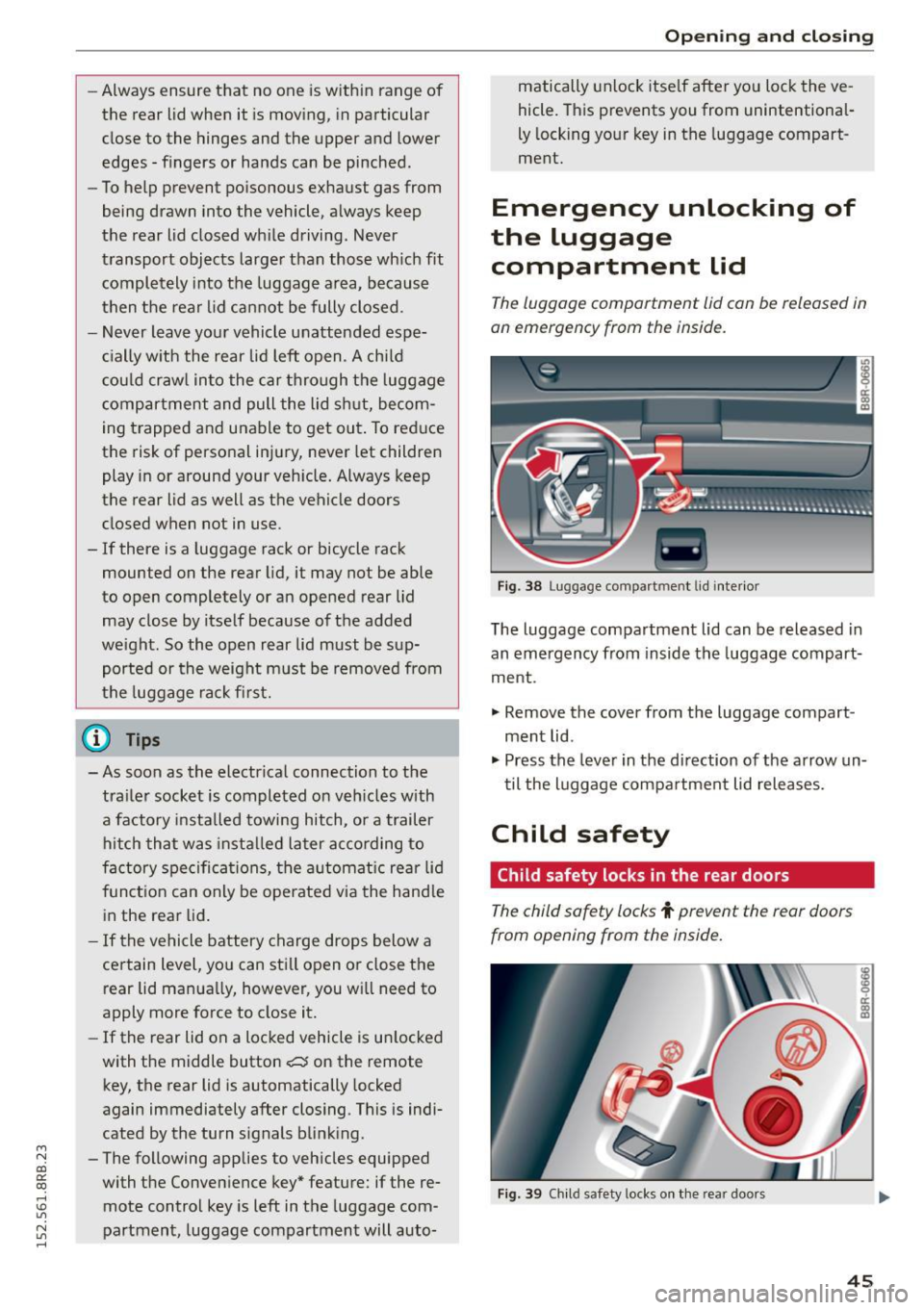
M N
co ~ co
rl I.O
"' N
"' rl
-Always ensure that no one is with in range of
the rear lid when it is mov ing, in particular
close to the hinges and the upper and lower
edges - f ingers or hands can be pinched.
- To help prevent po isonous exhaust gas from
being drawn into the vehicle, a lways keep
the rear lid closed wh ile driving . Never
transport objects large r than those wh ich fit
compl etely into the luggage area , because
then the rea r lid cannot be fully closed .
- Never leav e your vehicle unattended espe
c ially w ith the rear lid left open. A ch ild
c ou ld craw l in to the car through t he luggage
c ompartment and pull the lid s hut, becom
ing t rapped and unable to get ou t. To red uce
the risk of perso nal in jury, never let children
play i n or around your veh icle . Always keep
the rear lid as well as the vehicle doors
closed when not in use.
- If there is a luggage rack or bicycle rack
mounted on the rear lid, it may not be able
to open completely or an ope ned rear lid
may close by itse lf because of the added
we ight. So the open rear lid must be sup
ported or the weight m ust be removed from
the luggage ra ck fi rst .
(O} Tips
- As soon as the electrical connection to the
tra ile r socket is completed on veh icles with
a f actory insta lled towing hitch, o r a trailer
hitch that was insta lled later acco rding to
fac tory spe cifi ca tions , th e au tomat ic rear li d
fu nct ion can only be operate d via the hand le
in the rea r lid .
- If th e vehicle battery charge drops below a
certain level, yo u can sti ll open or close the
r ear lid manua lly, however, you w ill need to
apply more force to close it.
- If the rear lid on a locked vehicle is un locked
with the middle button
,c:$ on the remote
key, the rear lid is automatically locked
again immediately after closing. This is indi
cated by the turn s ignals bli nking.
- The f ollowing applies to veh icles equipped
with the Conve nience key" feature: if the re
mote control key is left in the luggage com
partment, luggage compartment will auto-
Open ing and clo sing
matically unlock itse lf after yo u loc k the ve
hicle. This prevents you from unintentional·
Ly locking yo ur key in the luggage compart
ment.
Emergency unlocking of
the luggage compartment Lid
The luggage compartment lid can be released in
an emergency from the inside.
Fi g. 3 8 Luggage co mpa rtment lid i nte rior
T he luggage compartment lid can be released in
an emergency from inside the luggag e compart
me nt.
., Remove the cover from t he luggage compart
ment lid .
., Press the leve r in the di rection of the arrow un
t il the luggage compa rtment lid releases.
Child safety
Child safety locks in the rear doors
The child safety locks t prevent the rear doors
from opening from the inside.
Fig . 39 Chil d safety locks o n th e rea r doo rs
45
Page 73 of 302
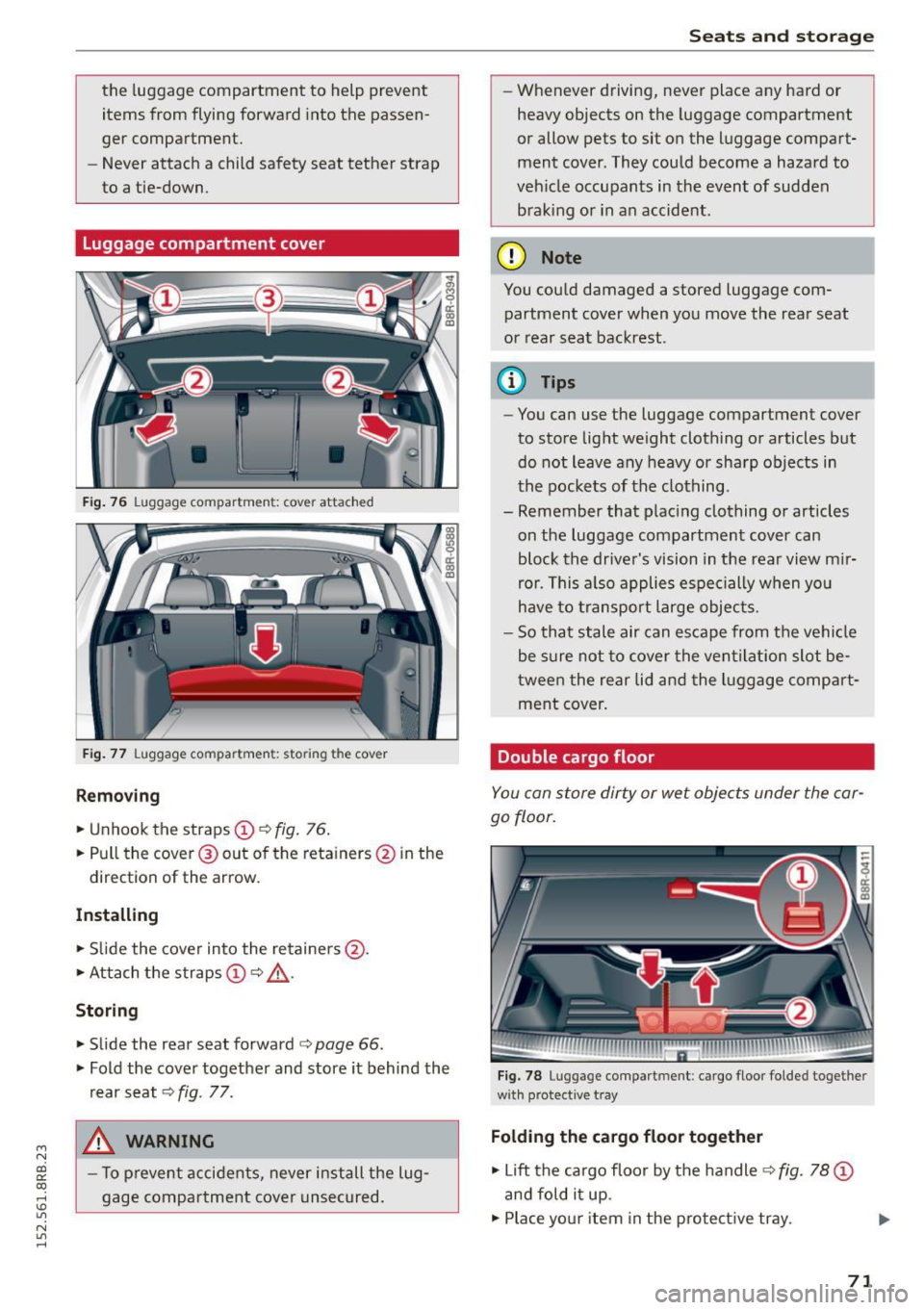
M N
co ~ co
rl I.O
"' N
"' rl
the lugg age compartment to help prevent
items from flying forward into the passen
ger compartment.
- Never attach a child safety seat tether strap
to a tie-down.
Luggage compartment cover
Fig. 76 Luggage compartment: cover attached
Fig. 77 Luggage compartment: storing the cover
Removing
"'Unhook the straps (!) c:> fig. 76.
"'Pull the cover @out of the reta iners @ in the
direction of the arrow.
Installing
"'Slide the cover into the retainers @.
"'Attach the straps
(D c:> ,&.
Storing
"' Slide the rear seat forward c:> page 66.
"' Fold the cover together and store it behind the
rear seat
c:> fig . 77.
A WARNING
- To prevent accidents, never install the lug
gage compartment cover unsecured.
-
Seats and storage
- Whenever driving, never place any hard or
heavy objects on the luggage compartment
or allow pets to sit on the luggage compart
ment cover . They could become a hazard to
vehicle occupants in the event of sudden
braking or in an accident .
(D Note
You could damaged a stored luggage com
partment cover when you move the rear seat
or rear seat backrest.
@ Tips
-You can use the luggage compartment cover
to store light weight clothing or articles but do not leave any heavy or sharp objects in
the pockets of the clothing .
- Remember that placing clothing or articles
on the luggage compartment cover can
block the driver's vision in the rear view mir
ror. This also applies especially when you
have to transport large objects.
- So that stale air can escape from the vehicle
be sure not to cover the ventilation slot be
tw een the rear lid and the luggage compart
ment cover.
Double cargo floor
You can store dirty or wet objects under the car
go floor.
Fig. 78 Luggage compartment: cargo floor folded togethe r
with protective tray
Folding the cargo floor together
"' Lift the cargo floor by the handle c:> fig. 78 (D
and fold it up .
"'Plac e your item in the protective tray. .,,.
71
Page 76 of 302
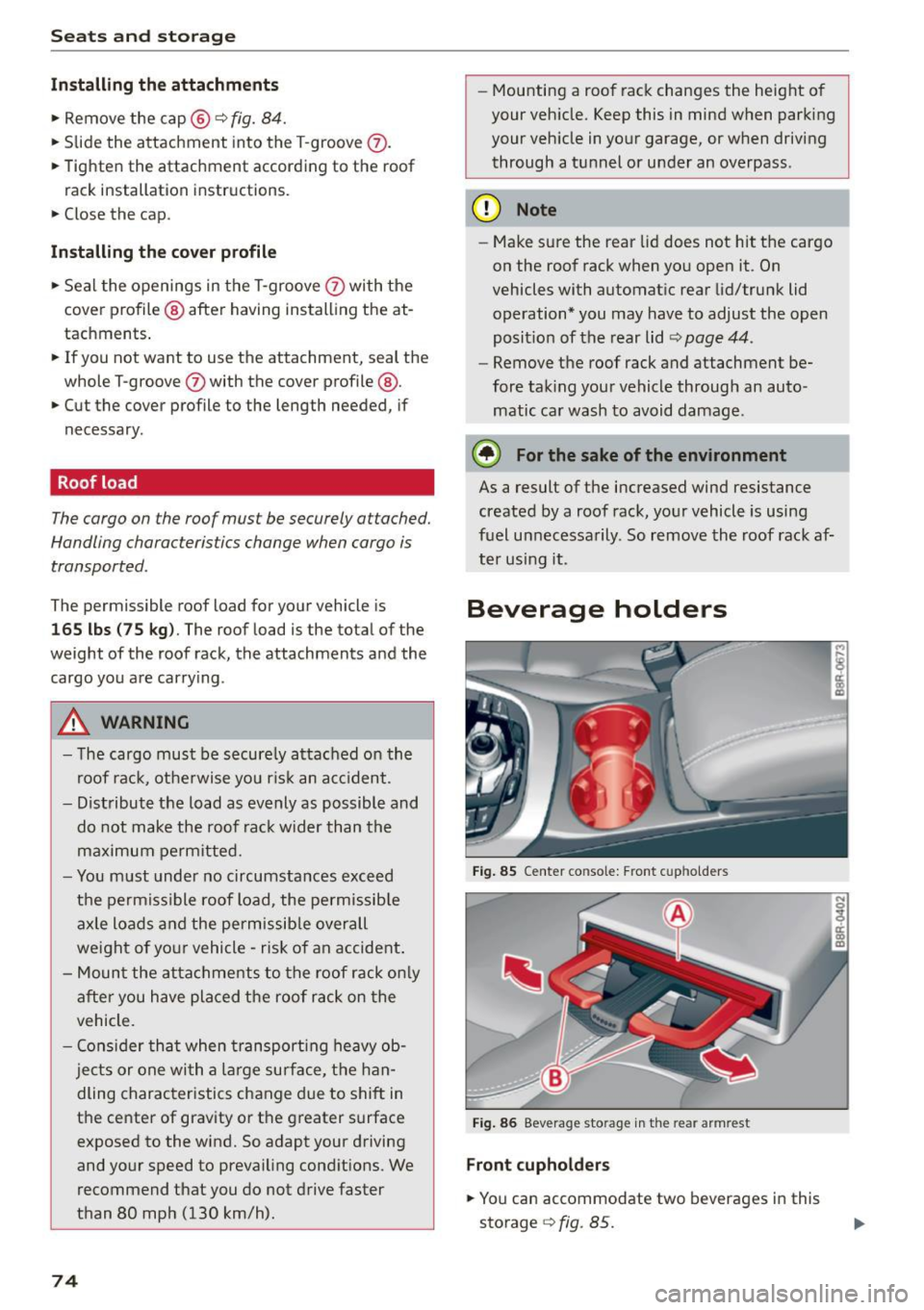
Seats and storag e
Install ing th e attachm ent s
.. Remove the cap @¢ fig. 84.
.. Slide the attachment into the T -groove (V .
.. Tighten the attachment accord ing to the roof
rack installation instructions.
.. Close the cap .
Inst a lling th e cov er p ro fil e
.. Seal the openings in the T-groove 0 with the
cover profile @ after having installing the at
tachments .
.. If you not want to use the attachment, seal the
whole T-groove
0 with the cover profile @.
.. Cut the cover profile to the length needed, if
necessary .
Roof load
The cargo on the roof must be securely attached.
Handling characteristics change when cargo is transported .
The permissible roof load for your vehicle is
165 lbs (75 kg ). The roof load is the total of the
weight of the roof rack, the attachments and the
cargo you are carry ing .
.,&. WARNING
-The cargo must be secure ly attached on the
roof rack, otherwise you r is k an acc ident .
- Distribute the load as evenly as possible and
do not make the roof rack wider than the
maximum permitted.
- You must under no circumstances exceed
the permiss ible roof load, the permissib le
axle loads and the permissib le overall
weight of your vehicle - risk of an accident.
- Mount the attachments to the roof rack on ly
afte r you have placed the roof rack on the
vehicle.
- Cons ider tha t when transport ing heavy ob
jects or one wi th a la rge surface, the han
dling characteristics change due to shift in
the center of gravity or the greater surface
exposed to the wind. So adapt your driving
and your speed to prevailing condit ions . We
recommend that you do not drive faster
than 80 mph (130 km/h) .
74
- Mounting a roof rack changes the height of
your veh icle. Keep this in mind when parking
your veh icle in your garage, or when driving
through a tunnel or under an overpass .
(D Note
-Make sure the rear lid does not hit the cargo
on the roof rack when you open it. On
vehicles with automat ic rear lid/trunk lid
operation* you may have to adjust the open
posit ion of the rear lid ¢
page 44 .
-Remove the roof rack and attachment be
fore taking your vehicle through an auto
matic car wash to avoid damage .
@ For the sake of the environment
As a result of the increased wind resistance
created by a roof rack, your vehicle is using
fuel unnecessarily. So remove the roof rack af
te r using it .
Beverage holders
Fig. 85 Center co nsole: F ront c upholder s
Fig . 86 Beverage sto rage in the re ar a rm rest
Front cuphol der s
.. You can accommodate two beverages in this
storage
<=> fig . 85.
Page 80 of 302
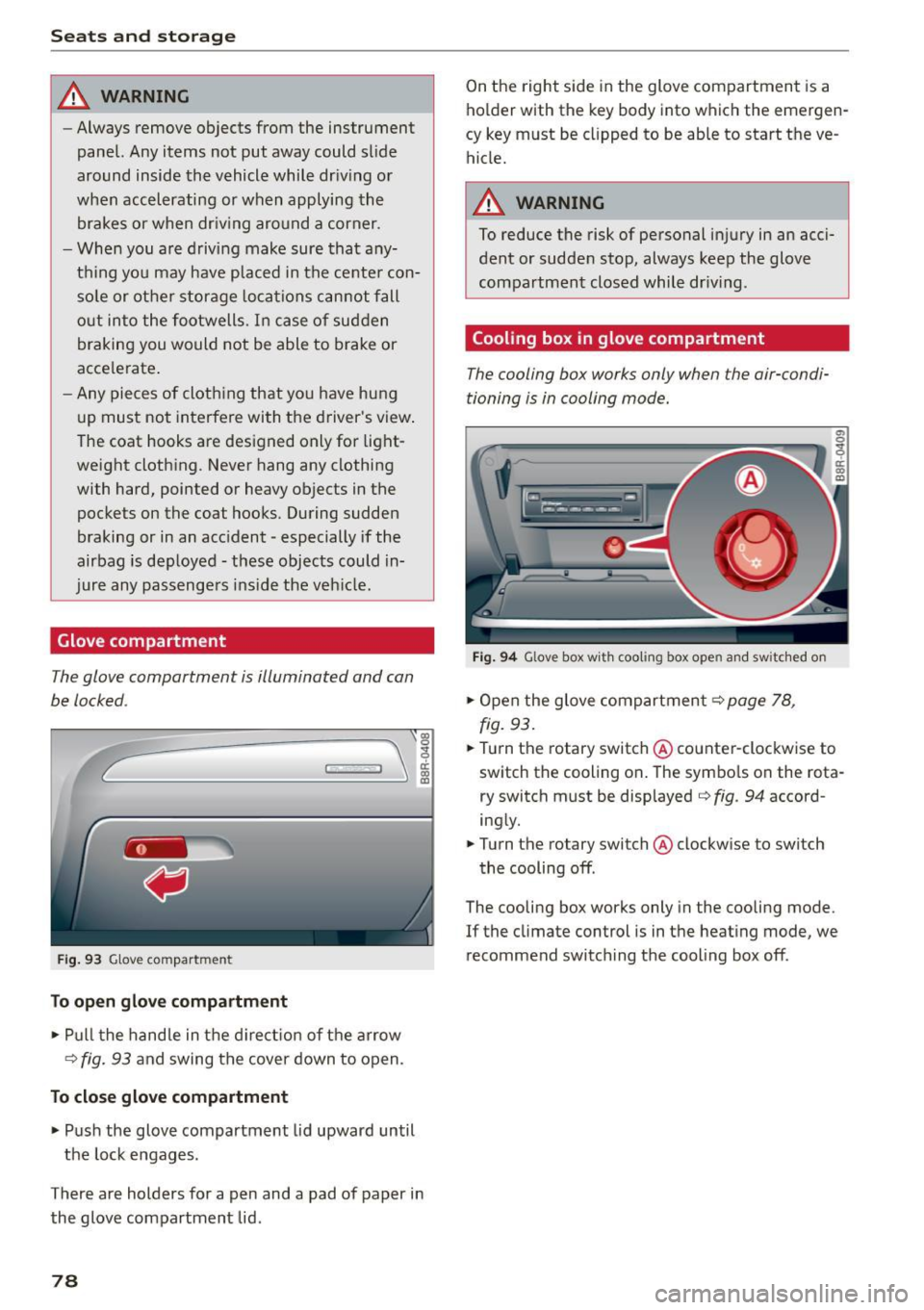
Seats and storag e
_& WARNING
-Always remove objects from the instrument
panel. Any items not put away could slide
around inside the vehicle while dr iving or
when accelerating or when applying the brakes or when dr iv ing aro und a corner .
- When you are driving make sure that any
thi ng you may have placed in the cente r con
so le or other storage loca tions cannot fall
o ut into the footwells. I n case of sudden
braking you would not be able to brake or
acce lerate .
- Any pieces of cloth ing that you have hung
up must not interfere with the driver's view .
The coat hooks are designed only for light
weight cloth ing . Never hang any clothing
with hard, pointed or heavy objects in the
pockets on the coat hooks. During sudden
braking or in an acc ident -especially if the
airbag is deployed -these objects could in
jure any passengers ins ide the veh icle.
Glove compartment
The glove comportment is illuminated and con
be locked .
C
Fig. 93 Glove compar tmen t
To open glov e compartment
,.. Pu ll t he hand le in the d ire ct io n of the arrow
¢
fig. 93 and swing the cover down to open .
To close glove compartment
.,. Push the glove compartment lid upward until
the lock engages .
There are holders for a pen and a pad of paper in the glove compartment lid .
78
On the right side in the glove compartment is a
ho lder with the key body into which the emergen
cy key must be clipped to be able to start the ve
hicle.
_& WARNING
To reduce the risk of personal inj ury in an acci
dent or sudde n stop, always keep the glove
compartmen t closed while dr iv ing .
Cooling box in glove compartment
The cooling box works only when the air-condi
tioning is in cooling mode.
Fig . 9 4 Glove box w it h coo li ng box ope n and s wit c hed on
.,. Open the glove compartment¢ page 78,
fig.
93 .
.,. Turn the rotary switch @counter-clockwise to
switch the cooling on . The symbo ls on the rota
r y switch must be displayed ¢
fig. 94 accord
ing ly .
.,. Turn the ro tary switch @clockw ise to switch
the cooling off .
The cooling box works only in the cooling mode.
If the climate con trol is in t he heat ing mode, we
recommend switch ing the cooling box off .
Page 81 of 302
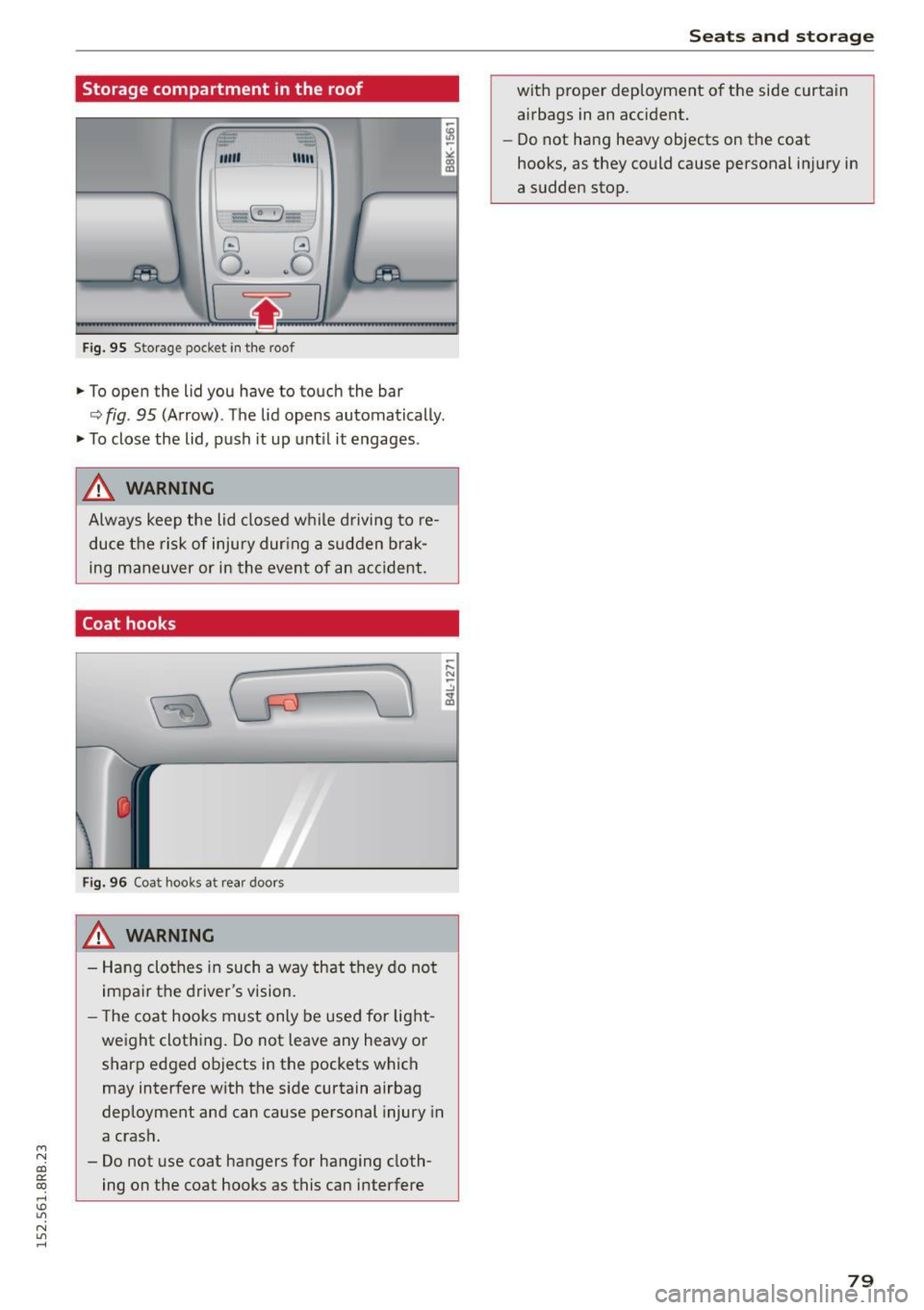
M N
co ~ co
rl I.O
"' N
"' rl
Storage compartment in the roof
""'
11111
'~-
8 G
o . . o
~
Fig. 95 Storage pocket in the roof
.. To open the lid you have to touch the bar
Q fig. 95 (Arrow) . The lid opens automatically .
.. To close the lid, push it up until it engages .
.&, WARNING
Always keep the lid closed while driving to re
duce the risk of injury dur ing a sudden brak
ing maneuver or in the event of an accident.
Coat hook s
Fig. 96 Coat hooks at rear doors
_& WARNING
-Hang clothes in such a way that they do not
impair the driver's vision.
- The coat hooks must only be used for light
weight clothing. Do not leave any heavy or
sharp edged objects in the pockets which
may interfere with the s ide curtain airbag
deployment and can cause personal injury in
a crash.
- Do not use coat hangers for hanging cloth
ing on the coat hooks as this can interfere
Seats and storage
with proper deployment of the side curtain
airbags in an accident.
- Do not hang heavy objects on the coat
hooks, as they could cause personal injury in
a sudden stop.
79
Page 93 of 302
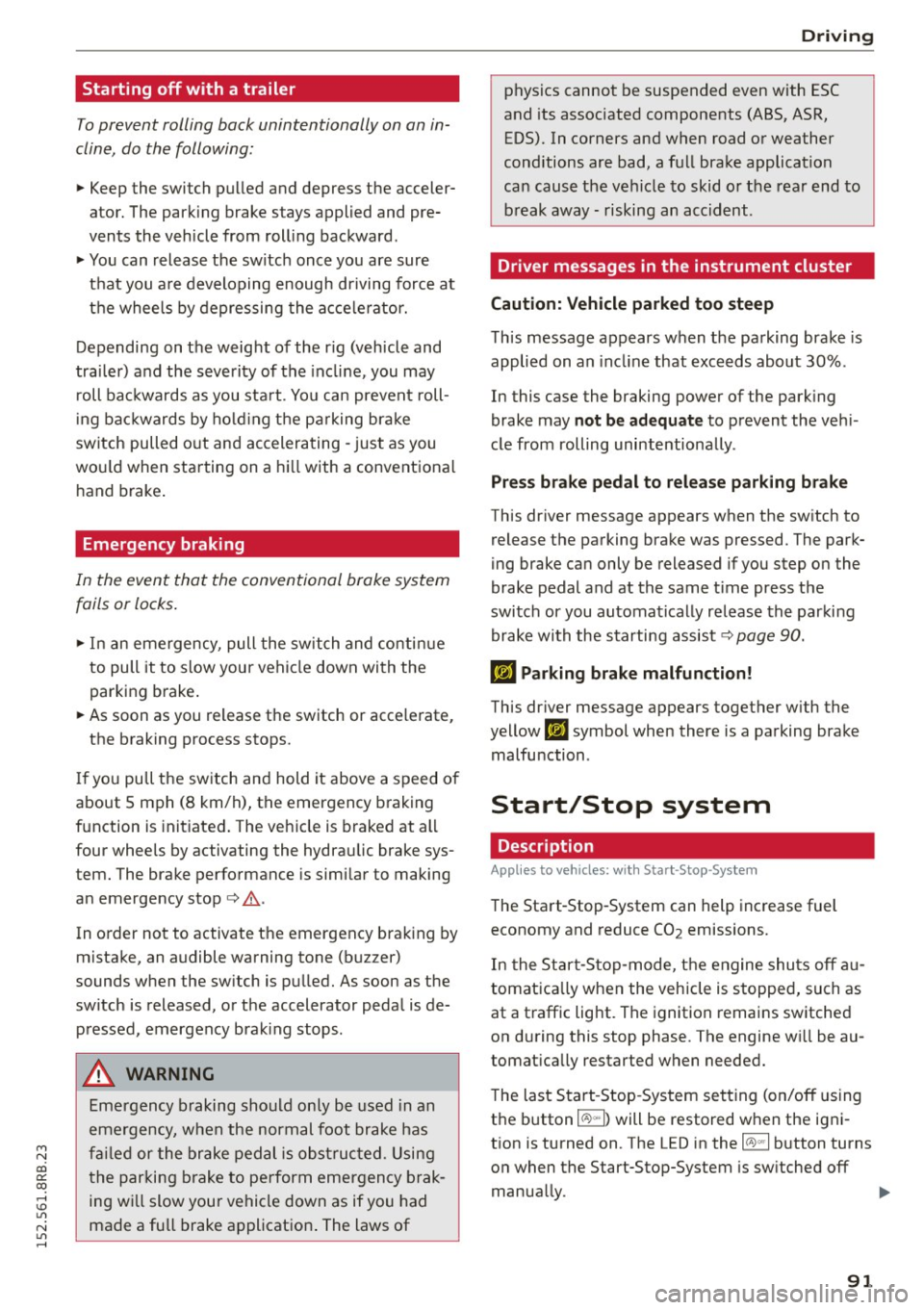
M N
co
a:
co
,...., \!) ..,.,
N ..,., ,....,
Starting off with a trailer
To prevent rolling back unintentionally on an in
cline, do the following:
11-Keep the switch pulled and depress the acceler
ator. The park ing brake stays applied and pre
vents the vehicle from roll ing backward .
11-You can release the switch once you are sure
th at you a re developing enough dr iving force at
the whee ls by depressing the a cce le rato r.
Depending on the weight of the r ig (veh icle and
trai ler) and the severity of the inc line, you may
r oll bac kwards as you sta rt . Yo u can prevent roll
in g ba ckwards by ho ld in g the pa rking brake
sw itch pulled o ut and accelera ting - just as you
wo uld when sta rting on a hill with a conventiona l
hand brake .
Emergency braking
In the event that the conventional brake system
fails or locks .
11-In a n eme rgency, pull the sw itch and conti nue
to pull it to slow your vehi cle down wi th the
parking brake .
11-As soon as you release the switch or acce le rate,
the braking process stops.
If yo u pull the sw itch and hold it above a speed of
about S mph (8 km/h), t he emergency braking
f u nction is init iated . The veh icle is braked at all
four whee ls by activating the hydra ulic brake sys
t em. The brake performance is simi lar to making
an emergency stop¢.&. .
In o rder not to activate the emergency brak ing by
mistake, an audible warning tone (b uzzer)
sounds w hen the sw itch is p ulled. As soon as t he
sw itch is released, or the accelerator peda l is de
p ressed, emergency brak ing stops.
A WARNING
Emergency b raking should on ly b e used i n an
eme rgency, when the normal foot brake has
f ail ed or the br ake pedal is obstruc ted. Using
t he par king brake to pe rform emergency brak
ing w ill slow your vehicle down as if you had
made a fu ll brake a pplicat ion . The laws of
Dri ving
physics cannot be suspended even with ESC
and its associated components (ABS, ASR,
EDS). In corners and when road or weather
c o nditions are bad, a f ull brake application
can cause the vehicle to skid o r th e rear end to
b reak away -risking an accid ent .
Driver messages in the instrument cluster
Caution: Vehicle parked too steep
T h is message appears w hen t he pa rking brake is
applied on an in cli ne that exceeds about 30% .
In this case the braking power of the park ing
brake may
not be adequat e to prevent the veh i
cle from rolling unintentionally .
Press brake pedal to release parking brake
This dr iver message appears when the sw itch to
release the parking bra ke was pressed. The par k
ing brake can only be released if you step on the
brake pedal and at the same t ime press t he
switch or you automat ica lly release the parki ng
brake with the starti ng assist ¢
page 90.
fpjj Parking brake malfunction!
This dr iver message appears together w ith the
yellow
rm symbol whe n there is a parking brake
malfu nction .
Start/Stop system
Description
Applies to veh icles: w ith Start -Stop -System
T he Sta rt-Stop -System can help increase fuel
economy and reduce CO2 emissions.
In the Star t-Stop -mode, the engine shu ts o ff au
tomatica lly when the vehicle is stoppe d, such as
at a t raffic lig ht. The ignition remains sw itche d
on during this stop phase. The engine w ill be au
tomat ica lly restarted when needed.
The last S tart -Stop -System sett ing (on/off using
t h e b utton
10 ~1) will be restored w hen the ig ni
t ion is turned on. The LED in the
l(A) ~I b utton turns
on when the Start-Stop-System is sw itched off
manua lly.
91
Page 143 of 302
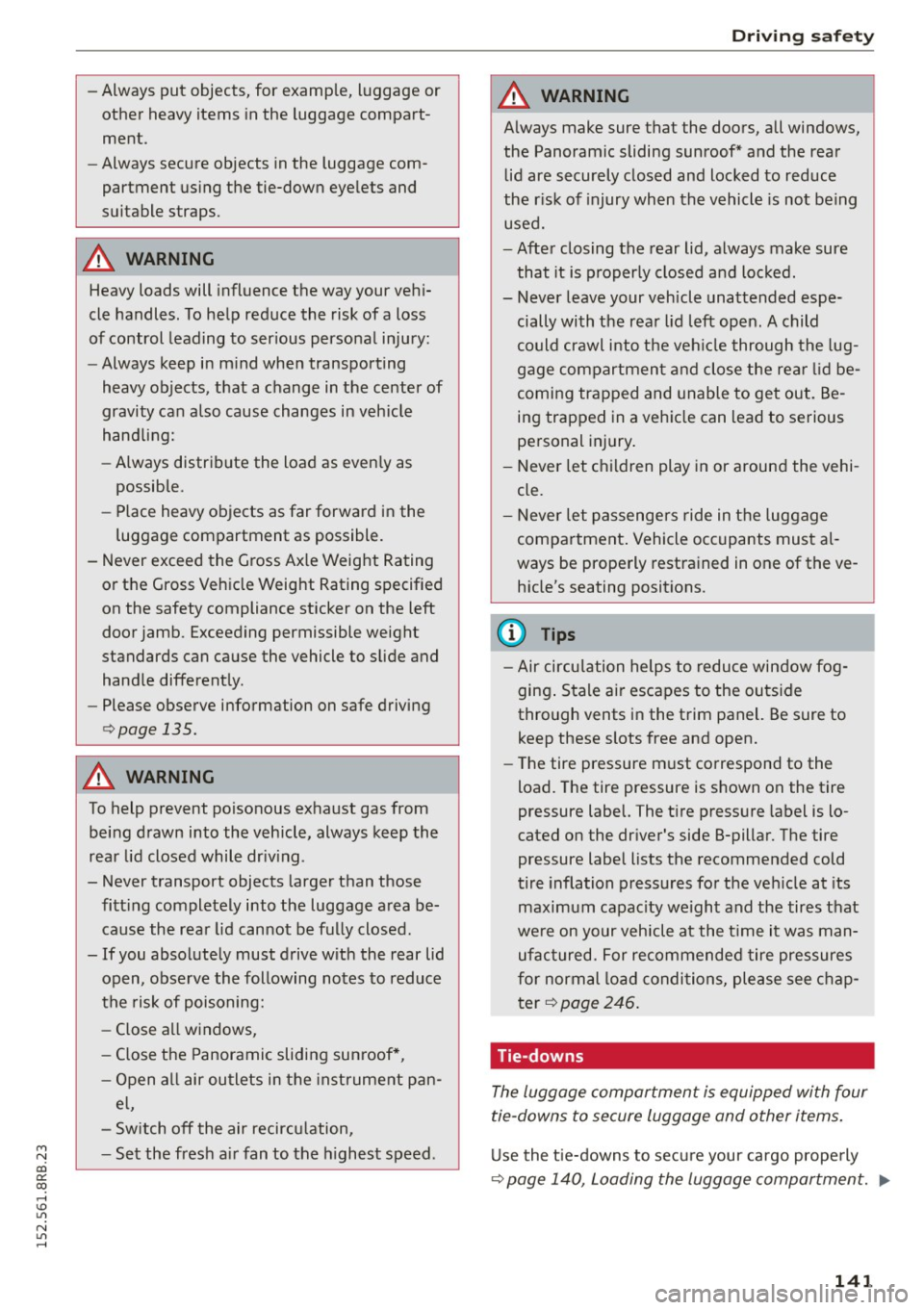
M N
co
a:
co
,...., \!) 1.1'1
N 1.1'1 ,....,
-Always put objects, for examp le, luggage or
other heavy items in the luggage c ompart
ment.
- Always secure objects in the luggage com
partment us ing the tie-down eye lets and
suitable straps.
A WARNING
Heavy loads will influence the way your vehi
cle handles. To help reduce the risk of a loss
of control leading to ser ious personal injury:
- Always keep in m ind when transporting
heavy objects, that a change in the center of
gravity can also cause changes in vehicle
hand ling:
- Always distribute the load as even ly as
possible.
- Place heavy objects as far forward in the
luggage compartment as possible.
- Never exceed the G ross Ax le Weight Rating
or the Gross Vehicle Weight Rating specified
on the safety compliance sticker on the left
doo r jamb. Exceeding permissible weight
standards can cause the vehicle to s lide and
hand le different ly.
- Please observe information on safe driving
r=>page 135.
A WARNING
To help prevent poisonous exhaust gas from
being drawn into the vehicle, always keep the
rear lid closed while driv ing.
- Never transport objects larger than those
fitt ing completely into the luggage a rea be
cause the rea r lid cannot be fully closed .
- If you absolutely must drive w ith the rear lid
open, observe the following notes to reduce
the risk of poisoning:
- Close a ll windows,
- Close the Panoramic sliding sunroof*,
- Open al l air outlets in the instrument pan-
el,
- Sw itch off the air recircu lation,
- Set the fresh ai r fan to the h ighest speed.
Dr ivin g s afet y
A WARNING
Always make sure that the doors, all windows,
the Panoramic sliding sunroof * and the rear
lid are securely closed and locked to reduce
the r is k of injury when the vehicle is not being
used.
- After closing the rear lid, always make sure
that it is p roperly closed and locked.
- Never leave your vehicle unattended espe
cially with the rea r lid left open . A child
could crawl into the ve hicle through the lug
g age compartmen t and clo se the re ar lid be
coming trapped and unable to get out. Be
ing trapped in a vehicle can lead to serious
pe rsonal injury .
- Never let children play in or around the vehi
cle.
- Never let passengers ride in the luggage
compa rtment . Vehicle occupants must al
ways be properly restrained in one of the ve
hicle's seating positions.
(D Tips
- Air circul ation helps to reduce window fog
ging . Stale ai r escapes to the outs ide
through vents in the t rim panel. Be sure to
keep these slots free and open.
- The tire pressure m ust correspond to the
load. The tire pressure is shown on the tire
pressure label. The t ire p ress ure label is lo
cated on the dr iver's side B-pillar. The tire
pressure label lists the recommended cold
t ire inflation pressures fo r the veh icle at its
maximum ca pac ity weight and the tires that
we re on your vehicle at the t ime it was man
ufac tured. For recommended tire pressures
for normal load condi tions, please see chap
ter
r=> page 246.
Tie-downs
The luggage compar tment is equipped wi th four
tie-downs to se cure luggage and other items .
Use the t ie-downs to secu re your cargo prope rly
r=> page 140, Loading the luggage compar tment. lliJ,
141
Page 144 of 302

Driving safet y
In a collision, the laws of phys ics mean that even
sma ller items that are loose in the vehicle wi ll
become heavy miss iles that can cause serious in
jury. Items in the vehicle possess energy which vary with vehicle speed and the weight of the item . Vehicle speed is the most significant factor .
For examp le, in a frontal coll is ion at a speed of
30 mph (48 km/h), the forces acting on a 10-lb (5 kg) object are about 20 t imes the normal
weight of the item . This means that the we ight
of the item would suddenly be about
200 lbs. (90 kg) . You can imagine the injuries
that a 200 lbs. (90 kg) item flying free ly through
the passenger compartment could ca use in a co l
lision like this .
A WARNING
Weak, damaged or improper straps used to
secure items to tie-downs can fa il during hard
bra king or in a collision and cause serious per
sonal injury.
- Always use suitable mounting straps and
properly secure items to the tie-downs in
the luggage compartment to help prevent
items from shifting or flying forward as dan
gerous missiles.
- When the rear seat backrest is fo lded down ,
always use suitable mounting straps and
properly secure items to the tie-downs in
the luggage compartment to help prevent
item s from flying forwa rd as dangerous mis
siles into the passenger comp art ment.
- Never attac h a child safety seat tether strap
to a tie-down.
Reporting Safety Defects
Applicable to U.S.A.
If y ou b eliev e that y our vehicl e
has a defe ct which could caus e a
cr ash or could cause injury or
d eath , you should immediately in
form the National Highw ay Tr affi c
Saf ety Admini stration (NHTSA) in
142
a d dition t o notif ying Audi of
Am eri ca, Inc .
If NHTSA r ecei ves similar com
plaint s, it may open an inve stiga
tion , and if it finds that a safety
defect s ex ists in a group of
v ehicles, it may order a recall and
remedy camp aign. How ever,
NHTSA cannot become in vol ved in
indi vidual pr oblems between you ,
your dealer, or Audi of America ,
Inc.
T o conta ct the NHTSA, you m ay
e ither call:
Tel.: 1-888-32 7-4 236 (TTY :
1-800-4 24-9 153) or
1-800-424-9393
or you ma y write to:
NHT SA
U .S . De part ment of Tran sp ort a
tion 1200 Ne w Jer sey A ve ., S. E.
W est Building
W ashington , D C 2 0590
You can also obtain other infor
mation about motor vehicle saf e
t y from:
http: / /www .s af ercar.g ov
Page 147 of 302
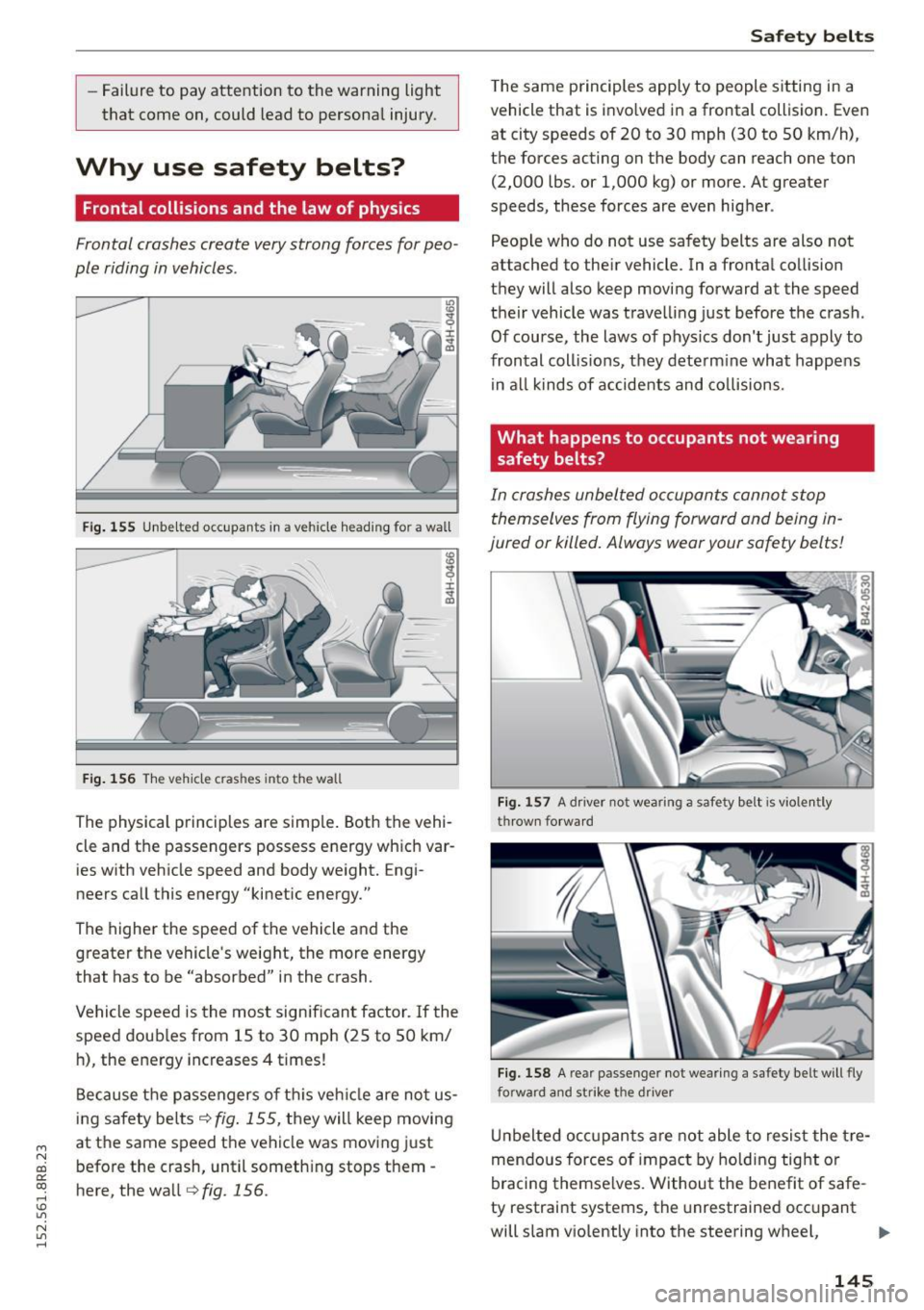
M N
co ~ co
rl I.O
"' N
"' rl
- Failure to pay attention to the warning light
that come on, could lead to personal injury.
Why use safety belts?
Frontal collisions and the law of physics
Frontal crashes create very strong forces for peo
ple riding in vehicles .
Fig. 155 Unbelted occupants in a vehicle heading for a wall
Fig. 156 The vehicle crashes into the wall
The physical principles are simp le. Both the vehi
cle and the passengers possess energy wh ich var
ies with vehicle speed and body weight. Engi
neers call this energy "kinetic energy."
The higher the speed of the vehicle and the
greater the vehicle's weight, the more energy
that has to be "absorbed" in the crash.
Vehicle speed is the most signif icant factor. If the
speed doubles from 15 to 30 mph (25 to SO km/
h), the energy increases 4 times!
Because the passengers of this vehicle are not us
ing safety belts¢
fig. 155, they will keep moving
at the same speed the vehicle was moving just
before the crash, until something stops them -
here, the wall¢
fig. 156.
Safety belts
The same principles apply to people sitting in a
vehicle that is invo lved in a frontal collision. Even
at city speeds of 20 to 30 mph (30 to 50 km/h),
the forces acting on the body can reach one ton
(2,000 lbs. or 1,000 kg) or more. At greater
speeds, these forces are even higher .
People who do not use safety belts are also not
attached to their vehicle. In a frontal collision
they will also keep moving forward at the speed
their vehicle was travelling just before the crash .
Of course, the laws of physics don't just apply to
frontal collisions, they determine what happens
in all kinds of accidents and co llisions.
What happens to occupants not wea ring
safety belts?
In crashes unbelted occupants cannot stop
themselves from flying forward and being in
jured or killed. Always wear your safety belts!
Fig. 157 A driver no t wearing a safety belt is violen tly
thrown forward
Fig. 158 A rear passenger not wearing a safety belt will fly
forward and strike the dr iver
Unbelted occupants are not able to resist the tre
mendous forces of impact by holding tight or
bracing themselves. Without the benefit of safe
ty restraint systems, the unrestrained occupant
will slam violently into the steering wheel, ..,_
145